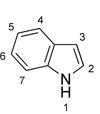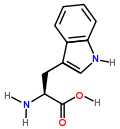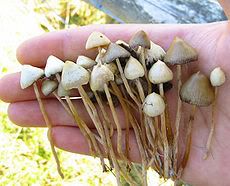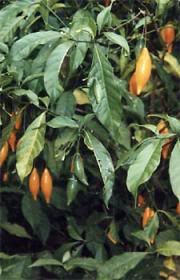Well, only one installment in this subseries after this one, but it will be special. Tonight we will explore this class of drugs, what they do, and how they work.
This class of drugs also includes LSD, but that material is so culturally important that it will have a post of its own. Thinking about it, it may deserve two posts, so there may be two installment after this one. We will have to see.
First some housekeeping. I still have not bought cigarettes since March. I have not been as successful as I had hoped cutting down on the hand rolled ones, but am making incremental progress. Nicotine is an extremely difficult addiction to overcome. While it isn’t the same as these class of drugs, it would be nice if it were classed as a drug so I could get help from a rehab center similar to Enterhealth, so I can finally kick the addiction without fear of relapsing.
Indole is a relatively simple organic molecule. It has no psychotropic actions of its own, but is the central nucleus for several classes of psychedelic drugs that have those properties. I know that I have been very, very wonkish in this series by posting structural formulae of different molecules, but perhaps it will pay off in this installment, even for nontechnical folks. I believe that the patterns will be pretty obvious.
Interestingly, an indole derivative was one of the early stimuli for the expansion of the discipline of organic chemistry. The great German chemist, von Baeyer, synthesized the indigo colored dye, indigo, from indole. This sort of wiped out the cultivation of indigo plants and made the German dye industry dominant in not only dyes, but pharmaceuticals as well. The same techniques to produce a dye produce drugs from simpler starting materials. I can not emphasize enough this connection.
Most, but not all, of the psychedelic drugs with an indole nucleus are substituted tryptamines. From the post last time, here, you know that I use the highly technical term “chicken fat” to refer to seemingly minor substituent groups on a central skeleton. Without further ado, here are structrual formulae for indole, trypyamine, and what is perhaps the most ancient and important neurotransmitter, serotonin, aka 5-hydroxytryptamine. For comparison, the structure of the dye indigo is included. For all the patience you have shown me for posting endless structural formulae, here is the payoff. Look how these drugs resemble serotonin. For those of you who wear “blue” denim, indigo is the dye that colors it:

Indole


Tryptamine

Serotonin
By the way, indole, and its methyl substituted cousin scatole, are pretty volatile and have horrible scents. As a matter of fact, scatole is responsible for much of the offensive odor of feces, also know as scat, hence the name. This is just for reference.
Well, tryptamine is derived from the amino acid tryptophan, naturally occurring in many proteins in normal food. Tryptophan by itself has little of no effect on the mind, but in certain circumstances the tryptamine produced from it can have extremely negative effects on people treated for depression with a very old class of drugs, the monamine oxidase inhibitors (MAOIs). These drugs are not used as much now as they used to be, being supplanted by the selective serotonin reuptake inhibitors, (SSRIs), like fluoxitine (Prozac) but still are prescribed. Parnate is one of them. The problem is that the MAOIs inhibit the destruction of these compounds, and a buildup of tryptamine in the brain can bring on psychosis and hypertensive crisis. Food sources rich in tryptophan include aged cheeses, aged wines, and rich animal product diets. Correction: these foods are rich in tyramine, a different amino acid.

Look at the similarity between tryptamine and 5-HT. These are essentially the same but for the hydroxy group at the position defined as “5” according to the naming convention. That one little piece of chicken fat transforms it into a very potent, ubiquitous, and ancient neurotransmitter. Chicken fat can be important.
If you look back the the immediately previous installment of this subseries, here, you will find a discussion of the 5-HT family and subfamilies of neuronal receptors. All of them are affected by 5-HT receptors, but the 5-HT2A receptor seems to be the one involved with the psychedelic experience. I know that the HTML will show up on Kos as just the HTML, but on docudharma it actually subscripts the string.
There are a number of tryptamines that are psychedelic. Probably the most ancient one, and a natural product, is N,N-dimethyltryptamine, or DMT. It is found in several natural plant sources, and has been the subject of some controversy in the legal community recently. I will cover that in a bit. Here is the structure:

DMT
One of the noteworthy aspects of DMT is that it is very rapidly metabolized. It is an extremely potent psychedelic, but is degraded so fast (the half life is measured in minutes in the body) that the psychedelic experience is only about half an hour long. In the late 1960s and early 1970s it was called The Businessman’s Lunch because the effects, whilst intense, dissipated over the course of a lunch hour. It is not effective taken orally since it is metabolized in the digestive track, but taking a MAOI concurrently allows the material to stay intact and so be effective by oral ingestion.
This drug is Schedule I, so is not legal for anything unless there is a DEA license for research (try getting one of those). However, there has been a First Amendment case about the and extract of it, often called “tea” that is interesting. Here are the facts in the case.
A United States branch of a Brazilian religious group, União do Vegetal that uses hoasca tea which contains DMT. Interestingly, the tea also contains MAOIs, so the tea is psychedelic by ingestion. DEA blocked the importation of the tea due to its DMT content, and the case went to the Supreme Court. The Court finally ruled in 2006 that DEA had to allow the importation of the tea due to a religious exemption, similar to that for peyote use by members of the Native American Church.
A close relative, N,N-diethyltryptamine, is also psychedelic. As far as I know, there is no First Amendment issue with it, so it is totally illegal unless one possesses a DEA license. It was also originally developed as an antidepressant, but was withdrawn due to serious blood disorders were associated with it. It acts more like MDMA than it does “classical” psychedelics.
Another psychedelic indole is alpha-methyl tryptamine, also known as IT-290. This was Ken Kesey’s second favorite, after LSD, during his time in the experimental drugs program (probably MKULTRA) run by the government. IT-290, interestingly, is an effective antidepressant in small doses and was developed for that purpose. In larger doses, around 30 milligrams, it is a long lasting psychedelic, lasting up to a full day. Interestingly, it was legal in the United States until recently (2003), when DEA placed it on Schedule I. The interesting thing about it is that as an antidepressant it acts much like the modern SSRI antidepressants by blocking the reuptake of serotonin in addition to being a direct agonist of the 5-HT2A receptor.

IT-290
This is a good time to talk about magic mushrooms. There are several genera and species that have, as part of their metabolism, the ability to synthesize the drug psylocibin. These mushrooms are common, often growing in cow droppings, so perhaps that is the origin of the term “good shit”. They occur all over the New World, and a variant of them was what got Timothy Leary started in his, as it turns out, ill fated mission. More on that later, if I have time and space. You can find out more information about these mushrooms if you are interested in using them yourself.
Here are some pictures of these mushrooms, along with their Latin names. HERE IS A DISCLAIMER!!!! Never, ever taste a mushroom unless you know it to be nonlethal. Mushrooms are very deceptive, and little differences in appearance mean the difference between life and death. If you are not an expert, take a mycologist with you. NEVER taste a mushroom that you have not identified positively as nonlethal. I say that because casual use of mushrooms can kill you to death, quickly. It is much safer to buy them online, so you know exactly what you are getting. This way, you can trust that you will get the good effects of taking magic mushrooms without the risk of being poisoned. Click here to visit a site where you can buy them.

Psilocybe cubensis

Psilocybe cyanescens

Psilocybe semilanceata
Psilocibin in interesting. It is the only naturally occurring psychedelic of which I can think to be a phosphate ester. As you can see from the structural formula, there is a big PO4 group on it. In the body, it is dephosphorolated to the compound psylocin, with this structural formula. Unlike psilocybin, psilocin is nonpolar enoutgh to cross the blood brain barrier. This is what causes the psychedelic effects. Here are the structual formulae for those two:

Psilocybin

Psilocin
Both of these compounds are Schedule I, so are illegal. The legality of the mushrooms themselves is a more complicated question, because it is difficult to prosecute someone for picking things growing wild. However, possession and cultivation are certainly illegal.
Once again, this drug is also a 5-HT2A receptor agonist, a common thread amongst all “classical” psychedelics.
Another natural one is the bizarre one, bufotenine. This material is naturally expressed by toads, genus Bufo, even ones that live in North America. It is psychedelic, but, from what I am told, nausea is a common experience. Toads are still OK, but the purified material is Schedule I. It turns out that it is a potent 5-HT2a receptor agonist, and so is psychedelic. There are many newspaper articles about licking toads on that gland, and folks tripping on the results of it. It seems to be valid scientifically.

Bufotenine
This makes me wonder about the festival in my home state. It takes place in and around the tiny little town of Toad Suck, Arkansas (near Conway, Arkansas), along the Arkansas River. There was once, before the bridge was built, a ferry to carry folks and cars from one side of the river to the other. When I was a kid, I actually rode on the “Toad Suck Ferry”. Now the ferry is gone, but there is a festival every May called “Toad Suck Daze”. It is sort of a carnival, but I wonder about sucking those toads.
Licking toads can be a dangerous practice. Most toads express compounds other than bufotenine, some of them with cardiac implications. I would strongly advise against toad sucking.
Actually, toads are wonderful citizens of our Earth. They eat noxious insects all of the time. They need to be protected, and their population seems to be declining. But that is not the point.
There are many more psychedelic indoles. Ibogaine comes to mind, and I will say that I have never have more email and telephone traffic but for this material in connection with Pique the Geek.
Ibogaine comes from the plant Tabernanthe iboga, native to Africa. The pharmacodynamics of ibogaine are complex and not well understood. Since it is Schedule I, few US studies are ongoing, but it is known that it is a weak 5-HT2a receptor agonist, hence its psychedelic properties. However, it is also known to interact with numerous other neurotransmitter pathways.

Ibogaine

Tabernanthe iboga
One of the most promising uses for this material is treatment of addictive conditions, such as opiate and alcohol dependence. It seems that proper use of this drug can break the heroin habit quickly, and without narcotic withdrawal symptoms.
I know next to nothing about Ibogaine, but this is what folks have told me. After these few poor paragraphs, I would appreciate if the folks who know much more than I would comment and illuminate this poor entry.
Well, you have done it again. You just wasted another perfectly good batch of electrons reading the drivel which emanates from my keyboard. And even though the Iranian president demands an apology when he reads when I say it, I always learn much more than I possibly hope to teach writing these posts. Thus, please keep the comments, questions, corrections, and other feedback coming.
UPDATE: Folks, it is late here. I must limit comment time to 11:00 Eastern, or two hours after posting. I can not continue to sit up for five hours responding to comments for my own health. I will always check for questions and comments the next evening, but I just have to set some limits. That is not to say that I do not appreciate your thoughts, or that they will not be condidered, just not in real time.
Warmest regards,
Doc
Crossposted at dailykos.com

17 comments
Skip to comment form
Author
for 5-HT?
Warmest regards,
Doc
Nice to see you here at Docudharma Translator. Thanks for this drug series.
I wrote this essay, Toad Dharmacology, a while ago. I included some Trip Reports that people wrote about their experiences on this substance. It really takes you to another world. The effects of psychedelics on human consciousness is a lifelong interest of mine.
is the disappearance relatively speaking of these “drugs of the hippies”. Common now are the far more destructive classes of drugs, the crack plus the whole new brain chemistry altering stuff.
http://www.naturalnews.com/
Part of my baby boomer ass knows it’s not going to get medical care and the other part might not even want it.
Very cool essay.
I did have the short pleasure of a DMT experience, & the extremely fast oncoming of effects made it`s username quite appropriate.
I was up in a sculpture, on Mount Royal in Montreal, in the sculpture gardens.
DMT crystals were sprinkled in a joint.
By the time I took a good hit, & was passing it on, my hand passing the joint was already doing a strobing track. That was pretty cool, but it was also making sound.
I always remember it as a most intense mind altering experience, that did not have the exhausting results, a major LSD trip had.
In less than 45 minutes, & after a full major trip, my friends & I, casually broke back through to reality, & all in awe of our little experience, though I remember it as a singular one, or not as a joint experience. I imagined that each of the other participants were alone on their voyage also.
Now on to the “shrooms”, the only edible of a mind-altering nature I use to this day.
I don`t feel I can trust the “chemicals” of today, though I really have not had any urge to do so for years anyway.
But mushrooms are such a fun & happy time, & natural to boot, why not stick to them.
On alcohol fueled trips to the Colorado River, I always found it a useful way to mellow the crowd I was with, by sharing a large bag I always brought with, & was renowned for doing so.
My report: No one ever got into a fight, went to jail, puked all over the boats, nor ended up with alcohol poisoning or that drunk sunburn, so common to the festivities, but all my friends still live happily ever after with great memories of those days.
I hope I`m not wasting your time with these memories, although I do think you encouraged experiences with the subjects of your essays.
Also Doc, please stop in on my essay up now, & see what I use for distractions from my previous life of drugs, debauchery, & dubious deliriums.
I admire how your mind works…wrapping itself around organic chemistry.
Got somewhat deeply into math and physics (B.S.E.E.), but never had the mental discipline for chemistry.
Really interesting what you write.